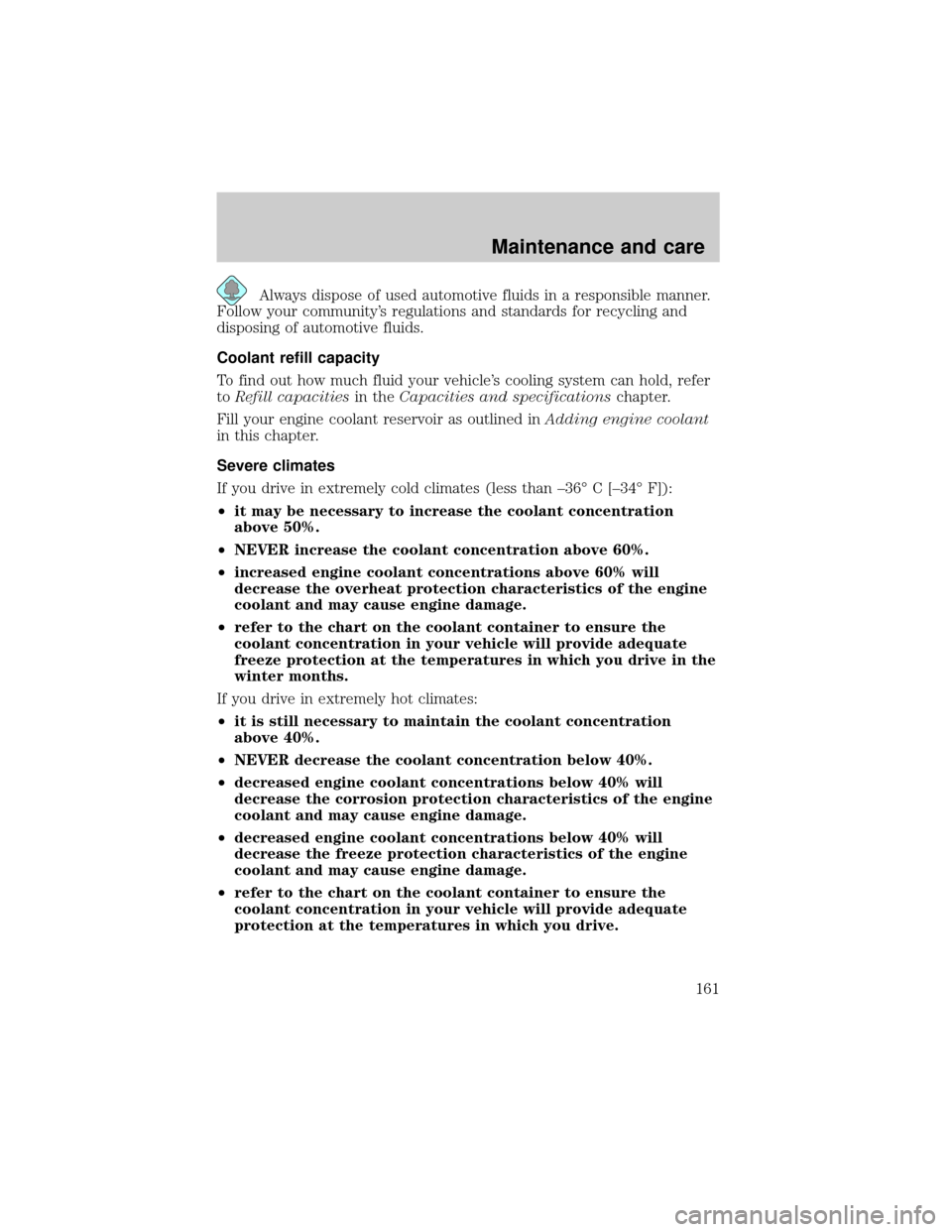2001 LINCOLN CONTINENTAL coolant temperature
[x] Cancel search: coolant temperaturePage 5 of 224

Vehicle Symbol Glossary
Child Safety Door
Lock/Unlock
Interior Luggage
Compartment Release
Symbol
Panic AlarmEngine Oil
Engine CoolantEngine Coolant
Temperature
Do Not Open When HotBattery
Avoid Smoking, Flames,
or SparksBattery Acid
Explosive GasFan Warning
Power Steering FluidMaintain Correct Fluid
LevelMAX
MIN
Emission SystemEngine Air Filter
Passenger Compartment
Air FilterJack
Check fuel cap
Introduction
5
Page 13 of 224

Speedometer
Indicates the current vehicle speed.
Odometer
The odometer is located in the message center. It registers the total
kilometers (miles) of the vehicle. Pressing the E/M control (if equipped)
will alternate between English (miles) and Metric (kilometers)
measurements.
Tachometer
Indicates the engine speed in
revolutions per minute.
Driving with your tachometer
pointer in the red zone may damage
the engine.
Engine coolant temperature gauge
Indicates the temperature of the
engine coolant. At normal operating
temperature, the needle remains
within the normal area (the area
between the ªHº and ªCº). If it
enters the red section, the engine is
overheating. Stop the vehicle as
soon as safely possible, switch off
the engine immediately and let the
engine cool. Refer toEngine
coolantin theMaintenance and carechapter.
80
MPH km/h0 2060
80
100
1200 204060100
120
140
160
180
200
40
ABS
RPMx1000AIR
BAG0 123456
7
NORM
CH
Instrumentation
13
Page 14 of 224

Never remove the coolant reservoir cap while the engine is
running or hot.
This gauge indicates the temperature of the engine coolant, not the
coolant level. If the coolant is not at its proper level the gauge indication
will not be accurate.
ELECTRONIC MESSAGE CENTER
The electronic message center only
works when the ignition is in the
ON position.
The message center tells you about
the condition of your vehicle by two
methods:
²operator selectable features
²continuous warning reporting of
monitored systems
You can select different features for
the message center to display by
using the message center controls
located to the right of the
instrument cluster. You will hear a tone when you press one of these
controls. However, the message center will display the appropriate
warning message if it detects a warning from any of the monitored
systems.
If you have a vehicle with the Driver
Select System, which allows you to
save operator selectable features to
DRIVER 1 or DRIVER 2, you have a
DRIVER ID control in place of the E/M control.
The message center will display theMemory Profile Systemfeatures
(operator selectable features) which are selected from the MENU and
VEHICLE HANDLING controls.
The Memory Profile System allows for two primary drivers to save their
individual seat and outside rearview mirror position preferences. The
feature will then be set to the remote entry transmitter, that will
automatically recall the saved individualized preferences. Refer toBasic
Operation of Memory Profile Systemin this section.
SYSTEM
E/M
MENU
TRIP
RESETSELECT
DISPLAY
DTE ECON VEHICLE HANDLING
DRIVER ID
Instrumentation
14
Page 114 of 224

Make sure the corresponding lights illuminate or illuminate briefly. If a
light fails to illuminate, have the vehicle serviced.
²If the driver's safety belt is fastened, the
light may not illuminate.
STARTING THE ENGINE
1. Turn the key to 5 (START)
without pressing the accelerator
pedal and release as soon as the
engine starts. The key will return to
4 (ON).
2. If the temperature is above ±12ÉC
(10ÉF) and the engine does not
start within five seconds on the first
try, turn the key to OFF, wait 10
seconds and try again.
3. If the temperature is below -12É C (10É F) and the engine does not
start in 15 seconds on the first try, turn the key OFF and wait 10
seconds and try again. If the engine does not start in two attempts, press
the accelerator pedal all the way to floor and hold. Turn the key to
START position.
4. When the engine starts, release the key, then release the accelerator
pedal gradually as the engine speeds up.
5. After idling for a few seconds, apply the brake and release the parking
brake.
Using the engine block heater (if equipped)
An engine block heater warms the engine coolant, which improves
starting, warms up the engine faster and allows the heater-defroster
80
MPH km/h
ABS
P!BRAKE
+ –
RPMx1000NORM
T/C
OFF
CHEF
FILL ON RIGHT
SERVICE
ENGINE
SOON AIR
BAG TURN ON
HEAD
LAMPS0 123456
7
0 2060
80
100
120
0 204060100
120
140
160
180
200
40
000000.0
P R N D 3 1
3
2
1
5
4
Starting
114
Page 161 of 224

Always dispose of used automotive fluids in a responsible manner.
Follow your community's regulations and standards for recycling and
disposing of automotive fluids.
Coolant refill capacity
To find out how much fluid your vehicle's cooling system can hold, refer
toRefill capacitiesin theCapacities and specificationschapter.
Fill your engine coolant reservoir as outlined inAdding engine coolant
in this chapter.
Severe climates
If you drive in extremely cold climates (less than ±36É C [±34É F]):
²it may be necessary to increase the coolant concentration
above 50%.
²NEVER increase the coolant concentration above 60%.
²increased engine coolant concentrations above 60% will
decrease the overheat protection characteristics of the engine
coolant and may cause engine damage.
²refer to the chart on the coolant container to ensure the
coolant concentration in your vehicle will provide adequate
freeze protection at the temperatures in which you drive in the
winter months.
If you drive in extremely hot climates:
²it is still necessary to maintain the coolant concentration
above 40%.
²NEVER decrease the coolant concentration below 40%.
²decreased engine coolant concentrations below 40% will
decrease the corrosion protection characteristics of the engine
coolant and may cause engine damage.
²decreased engine coolant concentrations below 40% will
decrease the freeze protection characteristics of the engine
coolant and may cause engine damage.
²refer to the chart on the coolant container to ensure the
coolant concentration in your vehicle will provide adequate
protection at the temperatures in which you drive.
Maintenance and care
161
Page 162 of 224

Vehicles driven year-round in non-extreme climates should use a 50/50
mixture of engine coolant and distilled water for optimum cooling system
and engine protection.
CHECKING AND ADDING POWER STEERING FLUID
Check the power steering fluid.
Refer to the scheduled maintenance
guide for the service interval
schedules. If adding fluid is
necessary, use only MERCONtAT F.
1. Start the engine and let it run until it reaches normal operating
temperature (the engine coolant temperature gauge indicator will be
near the center of the normal area between H and C).
2. While the engine idles, turn the steering wheel left and right several
times.
3. Turn the engine off.
4. Check the fluid level in the
reservoir. It should be between the
MIN and MAX lines. Do not add
fluid if the level is in this range.
5. If the fluid is low, add fluid in small amounts, continuously checking
the level until it reaches the range between the MIN and MAX lines. Be
sure to put the cap back on the reservoir.
Maintenance and care
162
Page 218 of 224

A
Accessory delay ..........................66
Air bag supplemental
restraint system ..................97, 101
and child safety seats ..............99
description ........................97, 101
disposal ....................................104
driver air bag ....................99, 102
indicator light .............9, 101, 103
operation ...........................99, 102
passenger air bag .............99, 102
side air bag ..............................101
Air cleaner filter .......................200
Air conditioning ..........................27
automatic temperature
control system ..........................27
Air filter, cabin ..........................167
Air suspension ...........................120
description ..............................120
Antifreeze
(see Engine coolant) ................157
Anti-lock brake system
(see Brakes) ......................116±117
Anti-theft system ........................69
arming the system ....................70
disarming a triggered system ..71
Audio system (see Radio) .........34
Automatic transaxle .................121
driving with .............................123
fluid, adding ............................163
fluid, checking ........................163
fluid, refill capacities ..............200
fluid, specification ..................202
Axle
lubricant specifications ..........201B
Battery .......................................165
acid, treating emergencies .....165
charging system
warning light .............................11
jumping a disabled battery ....144
maintenance-free ....................165
replacement, specifications ...200
servicing ..................................165
Belt minder .................................93
Brakes ........................................116
anti-lock ...........................116±117
anti-lock brake system
(ABS) warning light .........10, 117
brake warning light ..................10
fluid, checking and adding ....156
fluid, refill capacities ..............200
fluid, specifications .........201±202
lubricant specifications ..201±202
shift interlock ..........................121
Break-in period .............................3
C
Capacities for refilling fluids ....200
CD changer .................................44
Certification Label ....................203
Child safety restraints ..............104
child safety belts ....................104
Child safety seats ......................105
attaching with tether straps ..109
in front seat ............................107
in rear seat ..............................107
Cleaning your vehicle ...............194
engine compartment ..............197
exterior ............................195±196
exterior lamps .........................196
instrument cluster lens ..........198
Index
218
Page 220 of 224

Engine oil ..................................153
change oil soon warning,
message center .......................153
checking and adding ..............153
dipstick ....................................153
filter, specifications ........155, 200
recommendations ...................155
refill capacities ........................200
specifications ..................201±202
Exhaust fumes ..........................115
F
Floor mats ...................................69
Fluid capacities .........................200
Fuel ............................................176
calculating
fuel economy ....................23, 181
cap ...........................................178
capacity ...................................200
choosing the right fuel ...........179
comparisons with EPA fuel
economy estimates .................184
detergent in fuel .....................180
filling your vehicle
with fuel ..................176, 178, 181
filter, specifications ........180, 200
fuel filler door override ............68
fuel filler door release ..............68
fuel pump shut-off switch .....133
gauge .........................................12
improving fuel economy ........181
octane rating ...................179, 202
quality ......................................179
running out of fuel .................180
safety information relating
to automotive fuels ................176
Fuses ..................................134±135G
Garage door opener ....................57
Gas cap (see Fuel cap) ............178
Gas mileage
(see Fuel economy) .................181
Gauges .........................................12
engine coolant
temperature gauge ...................13
fuel gauge ..................................12
odometer ...................................13
speedometer .............................13
tachometer ................................13
GAWR
(Gross Axle Weight Rating) .....126
definition .................................126
driving with a heavy load ......126
location ....................................126
GVWR (Gross
Vehicle Weight Rating) .............126
calculating ...............................126
definition .................................126
driving with a heavy load ......126
location ....................................126
H
Hazard flashers .........................133
Head restraints ...........................84
Headlamps ...................................25
aiming ..............................192±194
autolamp system .......................26
bulb specifications ..................191
daytime running lights .............25
flash to pass ..............................26
high beam ...........................10, 26
replacing bulbs .......................186
turning on and off ..............10, 25
warning chime ..........................12
Index
220